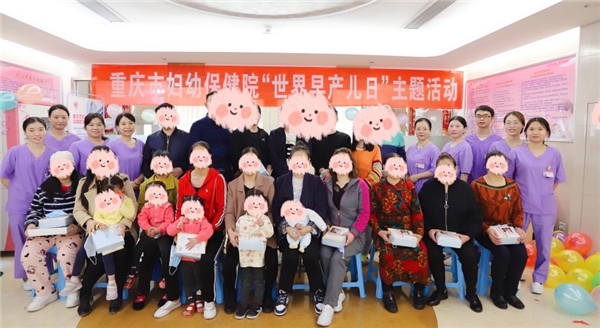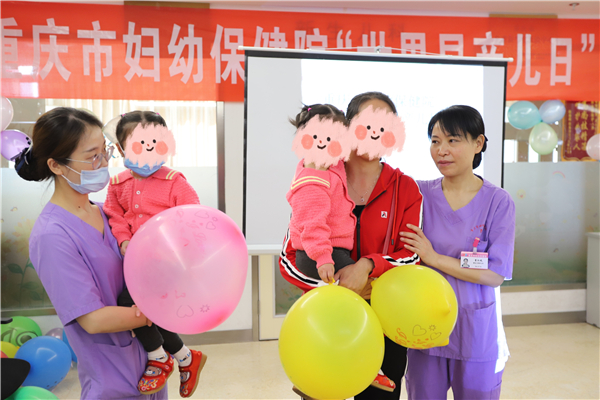Tips for parents who are nursing premature infants at home

Participants pose for a group photo with CQHCWC medics after the event for World Prematurity Day on Nov 15. [Photo/CQHCWC]
Nov 17 marks World Prematurity Day. To reduce the mortality rate in Chongqing, improve the health status and quality of life for premature infants, and raise social awareness of the plights faced by premature babies, Chongqing Health Center for Women and Children (CQHCWC) launched its fourth themed event for World Prematurity Day on Nov 15.
Due to environmental pollution, mental stress and other reasons, the number of premature infants has increased annually. Most of these babies need to be hospitalized, and when they are finally discharged and able to return home, their parents are often overwhelmed. Here are some helpful tips for parents who are nursing their premature babies at home.
1. How should parents prepare their homes for a premature baby?
(1). Goods that need to be prepared:
a. Baby crib – For safety reasons, the spacing between the slabs of the baby crib guardrail should not exceed 6 centimeters;
b. Cottony clothes, sheets, blankets;
c. Soft towels or non-irritating wipes (for cleaning and wiping the baby's butt);
d. Soft, breathable diapers;
e. Thermometer (at least twice daily temperature monitoring for baby);
f. Nasal aspirator (for cleaning up spilled milk from the mouth and nose when babies spit or choke);
g. In the case of breastfeeding, it is necessary to prepare breastfeeding underwear, breast pump, milk bottles, nipple shields, human milk fortifier, etc.;
h. Formula should be prepared if breastfeeding is not possible;
i. A pot or cabinet for sterilizing milk utensils;
j. Baby bathing utensils: bathtub, towel, etc.;
k. Others: room temperature thermometer, pacifier, etc.
Attention:
Babies do not need pillows within two months of corrected age;
When parents are not around, plush toys and other items should not be left beside the baby to avoid asphyxia;
Baby's cleaning products should not contain chemical fragrances;
Baby may not wear socks;
Buy oversized clothing and cut off the labels to avoid hurting the baby’s skin.
(2). Preparations for the home environment
a. All rooms should be thoroughly cleaned.
b. The color of the baby's room should be light and soft.
c. Keep the room temperature at 22-24℃ and relative humidity at 55 to 65 percent.
d. Indoor ventilation should be conducted at least three times a day for at least half an hour each time.
e. Reduce the light and noise stimuli to create a quiet environment for the baby.
(3). Caregiver preparation
Master the basic care of premature infants and observation of abnormalities by reading parenting books, attending lectures and consulting medics. Parents should learn to assess their baby's physiological needs and master the first aid technology for choking and apnea in infants.
2. Tips for home nursing
(1). Wash hands before and after touching premature babies to prevent the spread of germs.
(2). The bathing frequency of premature babies depends on the physical condition and skin condition of premature babies. The time for bathing should be one hour before or after feeding. If the baby has dry skin, appropriate emollient cream should be used under the advice of doctors.
(3). Because premature infants have hypoplasia of cardia, their stomach content can easily return to the mouth (milk regurgitation and spitting up). Thus, it is necessary to monitor feeding babies and provide more meals per day but with less milk each time. To avoid air entering the stomach, hold the baby upright after feeding, rest the baby's head on your shoulder and pat its back gently until it hiccups to remove air. If the baby vomits very frequently, appears restless or cries a lot, it may be an abnormal manifestation. Attention should be paid to avoid asphyxia, and prompt medical attention is recommended.
(4). Babies cry to different degrees, and it is essential to distinguish whether the crying is caused by intestinal colic (intestinal colic: the baby cries for more than three hours a day, at least three days a week, and more than three weeks in a row). Intestinal colic is more common in the two weeks after birth, most evident in the six to eight weeks period and disappears after three or four months, manifested as unexplained crying. Rubbing the baby's belly clockwise can help relieve the pain.

Kids and their mother pose for a photo with CQHCWC nurses during the event held on Nov 15. [Photo/CQHCWC]
3. Physical examination
(1). Vaccination
Premature babies lag in growth and development; they must be vaccinated under the evaluation of pediatricians.
(2). Follow-up of preterm infants
Systematic follow-ups are recommended for preterm infants at the neonatal specialist clinic, to dynamically monitor their growth and development abnormalities to achieve early detection and intervention.
4. Reasonable feeding
Breastfeeding is recommended. Breast milk has better nutritional advantages and provides protective antibodies for the baby, and reduces the chance of infection. Necrotizing enteritis is a hazardous disease, which typically occurs in premature babies. Breastfeeding could help to reduce the risk of morbidity.
If the mother does not have breast milk, it is recommended to use premature baby formula milk. Premature baby formula milk has higher calories than standard infant formula and better meets the nutritional needs of premature babies.
It is recommended to feed on demand rather than regularly and quantitatively. After going home, the initial feeding amount will gradually increase according to the doctor's advice. There is no uniform standard for how long babies need to be fed with premature milk. It is generally recommended that the baby drinks infant formula until its height and weight at the corrected age catch up with the standard weight and height of the same gestational age.
Therefore, parents of premature babies must regularly take their baby to the outpatient clinic for follow-up visits and decide whether to continue feeding premature milk to their babies according to the baby’s development situation (weight and height). The nutrition of premature babies cannot be supplied too quickly; generally, premature babies can complete growth catch-up at around 2 years old.

 CQHCWC: Nurture healthier futures for children
CQHCWC: Nurture healthier futures for children How to help children develop healthy eating habits
How to help children develop healthy eating habits Wechat
Wechat Weibo
Weibo